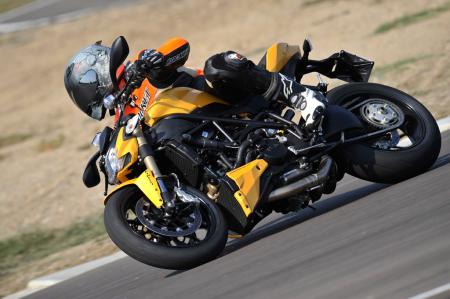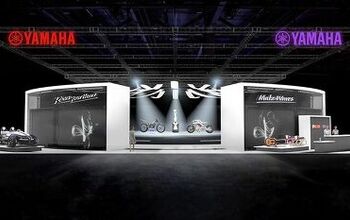2012 Ducati 848 Streetfighter Review - First Ride - Motorcycle.com
With the world launch of the 1199 Panigale superbike at the EICMA show in Milan still a month away, Ducati filled the interim with an international press launch of the 2012 848 Streetfighter. The combined street and track ride in and around Modena, Italy, exposed the newest naked performer to Sunday morning twisties and trackday duties.
Nearly identical in appearance to the larger 1098 Streetfighter, the new 848 is meant to provide motorcyclists a more affordable and less extreme option to the superbike-powered S model, which is the only other Streetfighter available for 2012 as the standard Streetfighter is being discontinued.
The most obvious difference between the two 2012 Streetfighter models is engine displacement. Whereas the Streetfighter S utilizes Ducati’s 1099cc L-Twin cylinder engine producing a claimed 155 hp and 89 ft.-lb. of torque at 9500 rpm, the new Fighter is powered by an 848cc Twin outputing a claimed 132 hp and 69 ft.-lb. of torque at 10,000 and 9500 rpm, respectively. Producing its peak horsepower 500 rpm higher in the rev range and with a compression ratio of 13.2:1, compared to the S’s 12.5:1, the new SF is a little more high-strung than the larger-displacement model.
Ducati’s crankshaft-derived power figures will decrease when run on a rear-wheel dyno. The 848 Superbike is factory-rated at 140 hp, 8 up from the new Streetfighter due to slightly less valve lift and duration, and it produced 119 hp on the Superflow dyno at Mickey Cohen Motorsports during our middleweight sportbike shootout. Thus, we expect the 848 SF to generate a little over 110 ponies at the rear wheel.
This amount of power is plenty fun and exciting on a bike weighing approximately 410 pounds full of fluids. On the street there’s enough oomph for any situation, whether it be wheelieing or passing, while on the track the 848 Fighter will make easy work of better bikes with lesser riders.
Set to retail at $13,000, the 848 Streetfighter is substantially more affordable than the $19,000 Streetfighter S but only $2000 less than the soon to be nonexistent $15,000 standard Streetfighter (hurry and get yours now if you perceive the standard 2011 1098 Streetfighter a better value). The 848 does retain Ducati Traction Control, which is a commendable technology to be included at such a low MSRP.
The bigger Streetfighter S model, in addition to the increased power of the larger engine, boasts an Ohlins fork whereas the 848’s front legs are of the Marzocchi variety. Both suspension components are fully adjustable and measure 43mm in diameter. The 848’s front end, however, is steeper than the S with 24.5 degrees of rake compared to 25.6 degrees on the S model. The 848 also has less trail than the S, 103mm vs 114mm, respectively, but the wheelbase of both bikes remains identical at 58.1 inches.
Whether on the street or the track the Streetfighter takes some time for the bike to feel comfortable and/or familiar. The front end on the 848 version as well as the 1099cc original can feel a bit twitchy, especially when leaned into a corner, and trail braking doesn’t come naturally when riding the Streetfighter. With the 848 spanning the same distance between contact patches as the S model but with a steeper rake and less trail suggests that Ducati may still be searching for a better base setup — which if achieved would go a long way in making the bike more inviting — but neither measurement lends itself to improved confidence.
Usually less rake and more trail would help calm down a nervous front end, so Ducati’s unconventional approach of more rake and less trail to apply calm is interesting. Without a 1098 Streetfighter to ride for comparative purposes at the event, it’s hard to say if the change in front end measurements are better or worse, with the issue still persisting, though, it’s definitely not solved.
It wasn’t until the second session on the track that I was riding comfortably fast, pushing the Streetfighter closer to the edge of its performance envelope. The front end’s nervousness and higher handlebars dictate a light touch — ham-fistedness results in a wandering front wheel.
Other significant differences of the 848 SF include a wet rather than dry clutch and new 10-spoke wheels instead of the five-spokers on the S. The tapered aluminum handlebars of the 848 are also 20mm higher than those of the S model. The high seat height of the S, 33 inches, carries over to the new 848, as do the slippery footpegs.
The majority of these changes comprise to make the new 848 Streetfighter a better companion to the motorcyclist who is more concerned with the competency of the Streetfighter as a usable streetbike and less about the upgraded performance of the S model.
The higher handlebars, for instance, relieve some of the pressure on a rider’s wrists allowing for more time spent in the saddle. Because Ducati didn’t go as far as to change the seating position itself, this extra leverage is oftentimes put to use maintaining a comfortable distance between fuel tank and crotch. The combination of a very narrow tank/seat junction and downward sloping seat can make bumpy road riding a testicle-harrowing experience.
On a smooth, closed course racetrack such as the brand new Autodromo Modena (the 848 Streetfighter press intro was the track’s first official function) the narrow seat/tank juncture allows for quick, side-to-side transitioning.
Complaints were made of the original Streetfighter that a rider’s right ankle was forced uncomfortably away from the bike due to an exhaust heat guard. Ducati addressed this on the 2012 848 SF by adding a 10mm spacer to the right footpeg. Yes, the ankle no longer feels at an odd angle, but the modification did take away a degree of lean angle on a bike that has riders touching toe sliders to tarmac in concert with placing a knee on the ground.
The twin front, radially-mounted Brembo brakes and 320mm discs provide good braking power and didn’t fade during our two track sessions, but feel at the adjustable lever is a little vague.
At the rear of the bike a fully adjustable Sachs shock attaches to a cast aluminum single-sided swingarm. The 5.5-inch rim holds a new 180/60 ZR17 Pirelli Diablo Corsa tire. The new size tire provides a wider contact area over its radius, and Pirelli claims improved damping capabilities to provide a smoother ride. Boasting a World Superbike compound on the right and left sides, the tire’s traction was never in question.
The 848 Streetfighter will be available in Fighter Yellow, Ducati Red and Dark Stealth but in any color the bike remains a stunner. The aggressive sex appeal of this motorcycle is undeniable, and if you can manage its few foibles, the 848 Streetfighter should make for a wonderful companion.
With the exception of the uncomfortable tank/seat juncture, the seating position provides plenty of leg room and a respectable distance from seat to footpegs. The higher handlebars will help keep the weight of a passenger off the rider’s back and the increased distance of the footpeg alleviates discomfort of the rider’s right foot.
I personally wouldn’t want to spend more than an afternoon on the Streetfighter, but for a motorcyclist looking for competent weekend carver and occasional track day tool the Streetfighter is all that in an attention-getting package.
Related Reading
2012 Ducati 1199 Panigale Preview
2009 Ducati Streetfighter Review
2009 Streetfighter Comparison: 2010 Ducati Streetfighter vs. 2008 Benelli TnT 1130
2011 Ducati Monster 1100 EVO Review
2011 Middleweight Sportbike Shootout: Street
2011 Middleweight Sportbike Shootout: Track [Video]
2010 Triumph Street Triple R vs. 2011 Ducati Monster 796 Shootout
2011 Ducati Diavel Carbon World Launch First Impressions
More by Tom Roderick

































Comments
Join the conversation